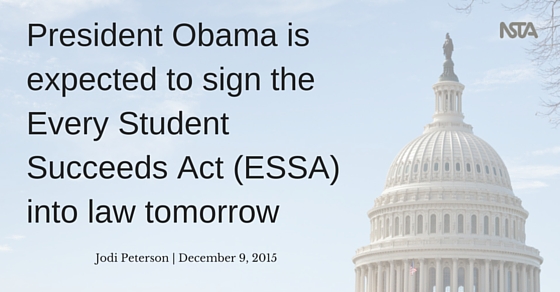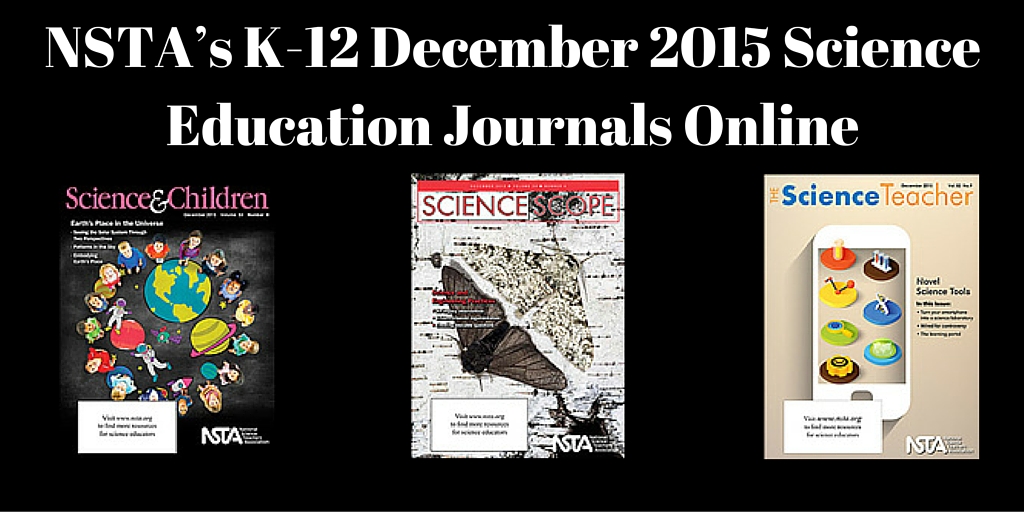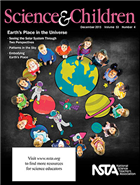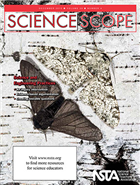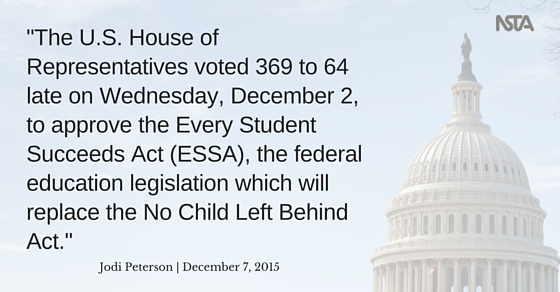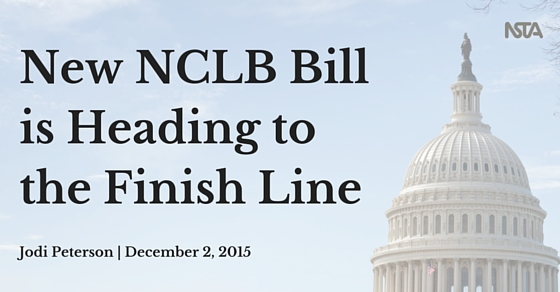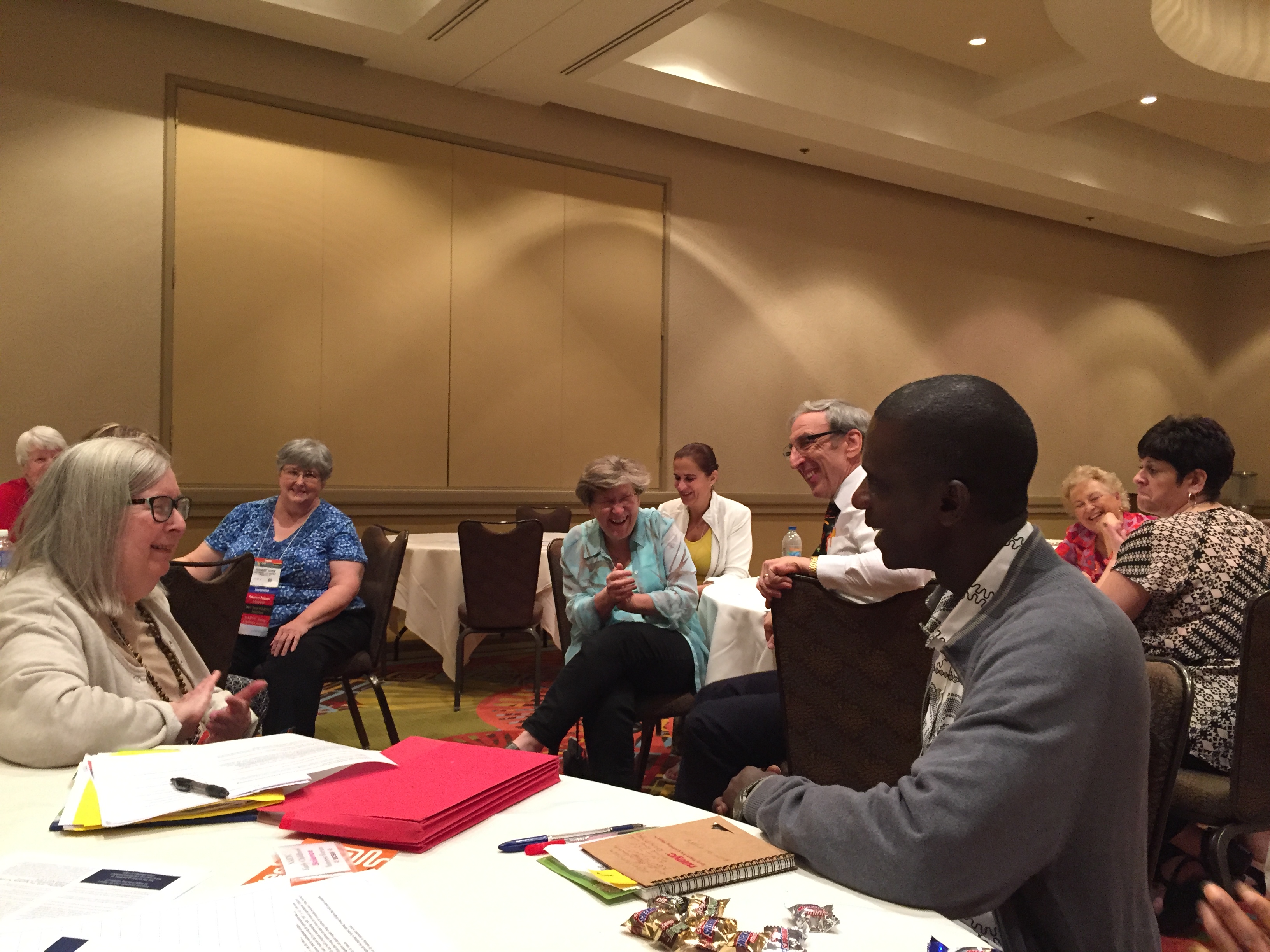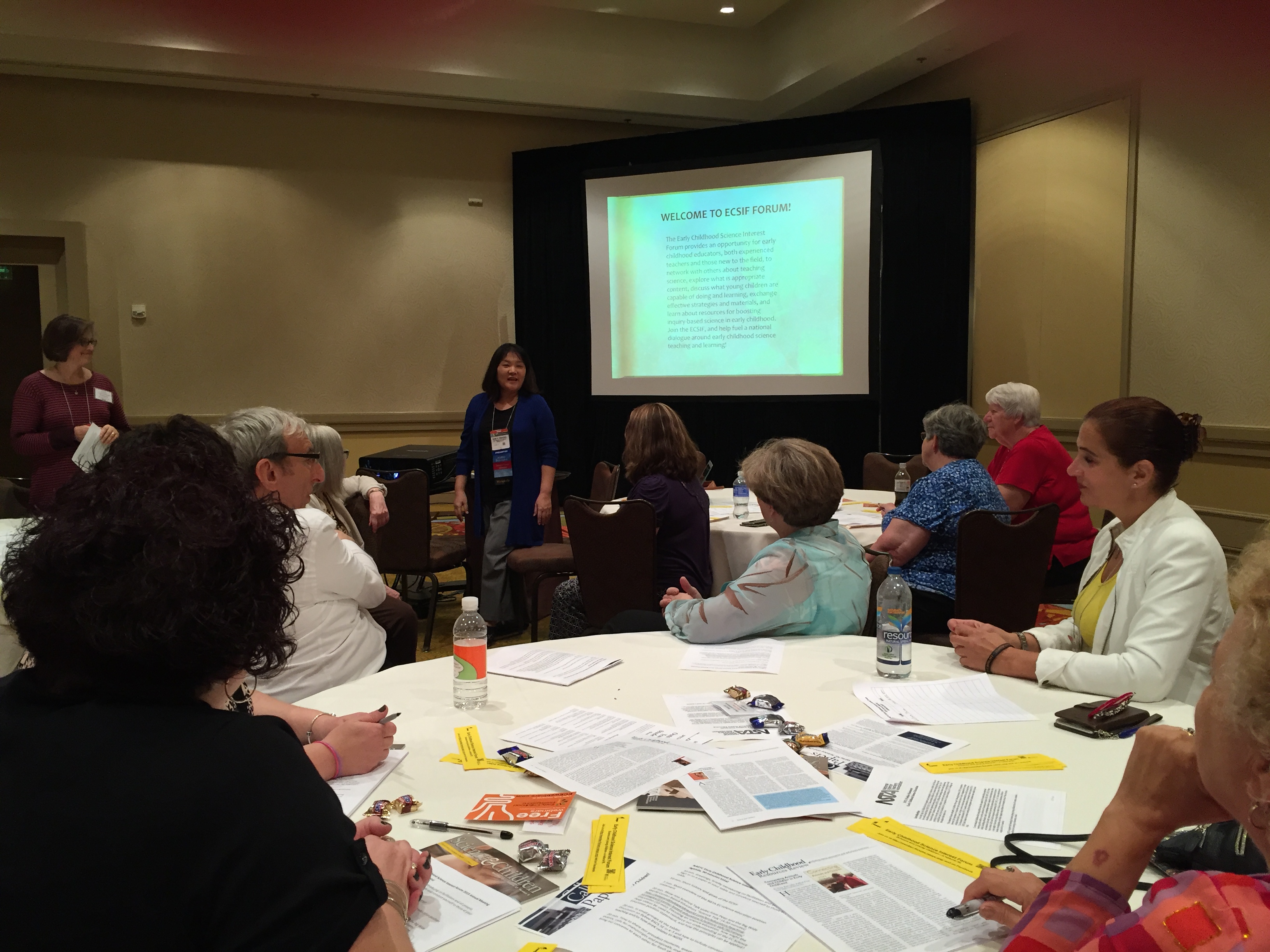Teacher-leaders
By Mary Bigelow
Posted on 2015-12-11
 My principal tells me I have “leadership potential.” I’ve been teaching Earth science for 11 years. I like my students and I feel confident with the curriculum. I don’t want to leave the classroom, but a little voice keeps whispering that she may be right. Should I try something new? —B., New York
My principal tells me I have “leadership potential.” I’ve been teaching Earth science for 11 years. I like my students and I feel confident with the curriculum. I don’t want to leave the classroom, but a little voice keeps whispering that she may be right. Should I try something new? —B., New York
What a vote of confidence from your principal! She must see something in you that can and should be shared with others. I can understand your hesitation to move to an administrative position, just as you have developed a repertoire of teaching strategies and a good rapport with students. But after 11 years you might be ready for new and challenging opportunities, in or out of the classroom.
I would listen to your little voice and look into your state’s requirements to earn credentials as a supervisor, principal, or curriculum specialist. In an administrative position, your insights and experience would make you a valuable resource for the science faculty. You would have first-hand experience with a teacher’s responsibility for safety in the labs and security in the storage areas. You would know how much behind-the-scenes work science teachers do, and you would be aware of the hazards (and possible liabilities) of scheduling non-science classes or study halls in lab classrooms. Working with a principal or curriculum director who understands the Next Generation Science Standards (NGSS) and the unique demands of science instruction would be a dream come true for many teachers.
Even if you work toward the credentials, it doesn’t mean you have to become a principal or central office administrator. The coursework, reflective processes, and internship can give you a big-picture look at schools as part of a system and how science education fits into school-wide issues and initiatives (I found the school law courses to be eye-opening). Having administrative credentials can open the door for other opportunities, too.
On the other hand, if you’re not ready for more coursework, perhaps becoming a “teacher-leader” would be a better option.
This includes a variety of roles within the school or district: an advocate for science on school committees and task forces, department chairperson, instructional coach, mentor for new or struggling teachers, advisory board member, grantwriter, team leader, or project director. You could get involved with curriculum development, conduct action research, pilot new technologies, or attend/present at school board meetings. These opportunities for teacher-leadership would not require leaving the classroom.
Professional development is another arena for teacher-leaders. You could offer workshops for teachers in your district or others. (A district I worked in used teacher leaders to do most of the summer academy sessions.) Or check with a regional service agency or informal science organization to see if they need workshop presenters or advisors. Consider sharing your experiences and expertise by writing articles for NSTA journals or presenting at conferences, too. It’s inspiring for others to hear from real practitioners.
Networking is an important part of being a teacher-leader, and social media provides many ways to work with and learn from our colleagues (for example, participating in NSTA’s discussion forums and e-mail lists, communicating with other teacher-leaders through Facebook, or participating in chats on Twitter)
As a potential teacher-leader or administrator, don’t underestimate the value of your contributions. I’m sure you have the skills and knowledge, as well as a passion for science, which will enable you to be a valuable resource not only to your students, but also to your school and to the profession. And it sounds like you already have a mentor for the process.
Senate Passes ESSA, President Obama to Sign Bill into Law Tomorrow, Dec. 10
By Jodi Peterson
Posted on 2015-12-09
On Weds. Dec. 9, the Senate approved the bill to reauthorize No Child Left Behind by a vote of 85 to 12, and President Obama is expected to sign the Every Student Succeeds Act (ESSA) into law tomorrow, ending the seven year effort to replace the widely unpopular 2002 federal education statute with a new law that provides much more power back to the states and local districts.
The 12 Senators voting against the bill were Sens. Roy Blunt (MO), Mike Crapo (ID), Steve Daines (MT), Jeff Flake (AZ), Mike Lee (UT), Jerry Moran (KS) , Rand Paul (KY), James Risch (ID), Ben Sasse (NE), Tim Scott (SC), Richard Shelby (AL) and David Vitter (LA). The three presidential candidates, Sens. Cruz, Rubio and Sanders, did not vote.
Last week, the House passed the bill by a vote of 369 to 64 on Wednesday, December 2, to approve the Every Student Succeeds Act.
The ESSA consolidates a number of programs (including the Math and Science Partnership) into a block grant to the states. Although it maintains the federal rule on testing (once every year in grades 3-8 for ELA and math and three times in science), the new law provide more opportunities for districts and states to develop and provide STEM opportunities to students and professional learning to teachers.
For background information on the bill to reauthorize No Child Left Behind and the Every Student Succeeds Act (ESSA) please read this blog.
Jodi Peterson is Assistant Executive Director of Legislative Affairs for the National Science Teachers Association (NSTA) and Chair of the STEM Education Coalition. e-mail Peterson at jpeterson@nsta.org; follow her on Twitter at @stemedadvocate.
The mission of NSTA is to promote excellence and innovation in science teaching and learning for all.
Follow NSTA
NSTA’s K-12 December 2015 Science Education Journals Online
By Korei Martin
Posted on 2015-12-09
Want to give your students a sense of the Earth’s place in the universe? Wondering how you can strengthen your students’ grasp of science and engineering concepts? Curious about how today’s technology can assist you in teaching? The December K–12 journals from the National Science Teachers Association (NSTA) have the answers you need. Written by science teachers for science teachers, these peer-reviewed journals are targeted to your teaching level and are packed with lesson plans, expert advice, and ideas for using whatever time/space you have available. Browse the December issues; they are online (see below), in members’ mailboxes, and ready to inspire teachers!
As scientists continue to investigate other planets and solar systems, understanding the universe has become increasingly important. This issue of S&C offers ways to help you deepen your students’ interest in Earth’s place in the universe.
Featured articles (please note, only those marked “free” are available to nonmembers without a fee):
- Adapt or Discard?
- Free – Editor’s Note: Earth’s Place in the Universe—Understanding Develops Over Time
- Free – Embodying Earth’s Place in the Solar System
- Fossil Explorers
- Map That Find!
- Patterns in the Sky
- Seeing the Solar System Through Two Perspectives
- Table of Contents
Having students construct an evidence-supported explanation of why an insect’s coloring might affect its population size is just one way to assess their mastery of specific science practices. You’ll find other strategies for assessing and strengthening students’ grasp of science and engineering practices inside this issue of Science Scope.
Featured articles (please note, only those marked “free” are available to nonmembers without a fee):
- Argumentation and Explanation: Tools for Using Them Together While Keeping Them Separate
- Assessing Science Practices: Moving Your Class Along a Continuum
- Authentic Science Investigation in the Classroom: Tools for Creating Original, Testable Questions and Graphical Hypotheses
- Free – Editor’s Roundtable: The End of the Grand Parade
- Free – My Journey to Understand and Implement the NGSS
- Present, Critique, Reflect, and Refine
- The ICAN Intervention: Helping Science Learners Make Connections to Content During Inquiry
- Table of Contents
In the classic 1980s Back to the Future films, the imagined world of 2015 contained an array of fantastic new technologies, from flying cars and hovering skateboards to flat panel televisions and video chat systems. We don’t yet have flying cars or hoverboards, but if the films’ characters could have time-traveled to a real 2015 science classroom, they would have been amazed by the technologies actually available to today’s teachers, tools unimaginable 30 years—or even a decade—ago. This issue describes some of these new technologies: GIS mapping tools to plot bird diversity, digital probeware to study the greenhouse effect, online simulations to investigate DNA and energy, and even cell phones as digital sensors to explore Newton’s laws of motion.
Featured articles (please note, only those marked “free” are available to nonmembers without a fee):
- Clearing the Air
- Climbing the NGSS Mountain
- Free – Editor’s Corner: The Future Is Now
- The Learning Portal
- Turn Your Smartphone Into a Science Laboratory
- Where the Birds Live
- Free – Wired for Controversy
- Table of Contents
Get these journals in your mailbox as well as your inbox—become an NSTA member!
The mission of NSTA is to promote excellence and innovation in science teaching and learning for all.
Follow NSTA
House Passes New Education Law, Senate Action Expected Week of Dec. 7
By Jodi Peterson
Posted on 2015-12-07
The U.S. House of Representatives voted 369 to 64 late on Wednesday, December 2, to approve the Every Student Succeeds Act (ESSA), the federal education law which will replace the No Child Left Behind (NCLB) Act. We anticipate the bill will go to the Senate for approval sometime the week of Dec. 7. President Obama is expected to sign the bill into law by year end.
NSTA has endorsed the bill, as noted in this Education Week article.
The bill was also endorsed by most, if not all, of the education and civil rights groups. A big endorsement from the National Governors Association (NGA) and a Wall Street Journal article helped to solidify Republican support in the House. (In their statement the NGA noted that ESSA endorsement “marks the first time that the National Governors Association has endorsed federal legislation since welfare reform in 1996.” The Wall Street Journal noted the bill “isn’t perfect but would represent the largest devolution of federal control to the states in a quarter-century. It’s far better than the status quo that would continue if nothing passes.”)
After the House vote on Dec. 2 Secretary of Education Arne Duncan and the White House praised legislators for passing the bill. In a statement the White House said “The bill rejects the overuse of standardized tests and one-size-fits-all mandates on our schools, ensures that our education system will prepare every child to graduate from high school ready for college and careers, and provides more children access to high-quality state preschool programs.” They called on the Senate to act this week.
Read more about the STEM education provisions in ESSA.
Here are some key highlights in the new bill.
- The new bill eliminates the NCLB highly qualified teacher requirement. States are no longer required by the federal government to do teacher evaluations using student outcomes.
- A $1.6 billion block grant (Title II) consolidates a number of programs, including the Math and Science Partnership program. However there are funding opportunities for STEM teacher professional development, leadership training, grants for performance pay and differential pay, and alternative cert programs throughout the bill in both Title II and Title IV available to both states and districts (more on that here).
- Adequate Yearly Progress AYP is gone. States would test students in reading and math in grades 3 through 8 and once in high school and continue to report on data for the schools and the subgroups of students (such as ELL students, special education students, low income, and minorities). Science testing would continue in the bill, once in elementary grades, once in middle level, and once at high school (similar to current law)
- States would decide what to hold schools and districts accountable for and how to intervene in low performing schools. They must use test scores in accountability frameworks, but also must include multiple measures. States are required to identify and intervene in schools with the bottom 5 percent of performers and intervene in high schools where the graduation rate is 67 percent or less.
- States must adopt “challenging” academic standards. The bill restricts the powers of the Secretary of Education and specifically prohibits the U.S. Secretary of Education from incentivizing, forcing, or coercing states into adopting Common Core, or interfering with a state’s right to develop or change its own set of standards and assessments.
- States to create their own testing opt-out laws but it must maintain the 95 percent student participation federal requirement.
Read the bill here.
Read the Education Week article on the bill here.
There will be more to come on the new federal education law in weeks ahead as we take a deep dive into the 1000-plus-page bill.
Jodi Peterson is Assistant Executive Director of Legislative Affairs for the National Science Teachers Association (NSTA) and Chair of the STEM Education Coalition. e-mail Jodi at jpeterson@nsta.org; follow her on Twitter at @stemedadvocate.
The mission of NSTA is to promote excellence and innovation in science teaching and learning for all.
Follow NSTA
17 Things You'd Only Hear if You Were at #NSTA15 in Kansas City Last Week
By Lauren Jonas, NSTA Assistant Executive Director
Posted on 2015-12-06
They come to conferences for intensive professional learning, nationally renowned speakers, and exhibit hall swag… but what science teachers really come to NSTA for are the moments you wouldn’t get anywhere else!
#1 …today I lassoed a beetle
#wcedchat #NSTA15 #carolinaredcarpet Today I lassoed a beetle and it pulled things.Who doesn’t like science again?? pic.twitter.com/fYJ33al24f
— Kayla Howard (@kaycards) December 3, 2015
#2 … the moment when you buy pangea cookie cutters from a Super Bowl champ
The moment when you buy a pangea cookie cutters from a Super Bowl champ. #NSTA15 pic.twitter.com/wM1gz2Zadk
— Kara Luce (@karalu79) December 4, 2015
#3 …I’m learning about the zombie apocalypse
While I’m not with my kids today I’m learning about the zombie apocalypse at #NSTA15 #12daystwitter pic.twitter.com/Y86MtYgiR7
— Candace Johnson (@MsJ_Tigers) December 4, 2015
#4 …it’s a spleen!
Hey #RoomE102…look what I brought home from #nsta15 today! IT’S A SPLEEN! #SmileWhenYouSayThat pic.twitter.com/XAeCZj9Cvu
— Eric Magette (@mistermagette) December 4, 2015
#5 …are you just bartling puzballs?
Do you REALLY understand the concept or are you just “bartling puzballs”? https://t.co/X4oZjB2xc4 @CTSKeeley #NSTA15 pic.twitter.com/X9lMw1OjcG
— Ryan Lacson (@noscals) December 3, 2015
#6 …I made a butterfly necklace today!
I made a butterfly necklace today! #NSTA15 pic.twitter.com/dfJn5TK5Fd
— Bonnie Stafford (@6thScienceTeach) December 3, 2015
#7 …STEMstars are popping up everywhere
#STEMstars are popping up everywhere here at #NSTA15 KC! pic.twitter.com/CX0WXsAnDj
— NatSciTeachAssoc (@NSTA) December 3, 2015
#8 …received 2 dogfish sharks
Received 2 dogfish sharks at #NSTA15 conv @madjane100 guess what we get to do #emwolves pic.twitter.com/WMTdpcOPJE
— Lorie Sliefert (@lsliefert) December 3, 2015
#9 …just made poop!
#NSTA15 thanks @NSTA for teaching us about the digestive system pic.twitter.com/38FSuwEbx2
— Christi Schumaker (@cschumaker1) December 3, 2015
#10 …your phone lets you see infrared
Selfie mode on your phone lets you see infrared! #nsta15 pic.twitter.com/GEaJYmWNI0
— Ms West (@MsWest415) December 4, 2015
#11 …I constructed a wind turbine
Coach Hall and I constructed a wind turbine & made electricity while representing @CotterWarriors at #NSTA15! pic.twitter.com/yE9ucA3e8P
— LaDonna Mendleski (@LDM_Teach) December 3, 2015
#12 …so many people who love science
Great to hang out with so many people who love science! Thanks @cindymagnifico for setting this up! #NSTA15 pic.twitter.com/3Dsa0SYPgk
— Dave Nowak (@dnowak77) December 3, 2015
#13 …wouldn’t be an NSTA conference without a shelfie
Wouldn’t be an NSTA conference without a shellfie. Yes. That was intentional. #NSTA15 pic.twitter.com/ho5cOX4ggT
— Robert Starr (@A_smarter_Starr) December 4, 2015
< /p>
#14 …ask the local police department for electronic balances they have from drug busts
#NSTA15 learning to ask the local police department for electronic balances they have from drug busts #sciencerocks pic.twitter.com/OwDRd9OaSf
— Mrs. Wangeman (@ChemLes) December 4, 2015
#15 …the spaghetti marshmallow challenge is on!
The #SpaghettiMarshmallowChallenge is on! @AAPTHQ #NSTA15 #STEM #engineering pic.twitter.com/tAbaplnb9k
— Steve Maier (@SteveMaier_) December 4, 2015
#16 …we are superheroes
We are superheroes! #NSTA15 #FischerScientific #LHS #IrishPride pic.twitter.com/ZBY2cm7BAr
— Elizabeth J Jones (@Elisamaj) December 4, 2015
#17 …first session this morning gave me a lesson idea for Monday!
First session this morning gave me a lesson idea for Monday! Cant wait! #NSTA15
— Sarah Samuelson (@SciSarahSam) December 5, 2015
They come to conferences for intensive professional learning, nationally renowned speakers, and exhibit hall swag… but what science teachers really come to NSTA for are the moments you wouldn’t get anywhere else!
House of Reps Set to Vote on NCLB Bill Today: Updated December 3, 2015
By Jodi Peterson
Posted on 2015-12-02
December 3, 2015 Update
The House of Representatives voted 369 to 64 late on Wednesday, December 2, to approve the Every Student Succeeds Act, the federal education law which will replace the No Child Left Behind Act. The bill now goes to the Senate for their approval as soon as next week, then to the President by year end for his signature.
On Monday, November 30, House and Senate education committee leaders released the final legislative language of the Every Student Succeeds Act, the bipartisan bill that will replace the No Child Left Behind Act (NCLB).
This legislation is scheduled to go to the House floor for final consideration this afternoon (Dec. 2) , then to the Senate for a final vote next week. President Obama is expected to sign the bill into law by year end. NSTA has endorsed the bill (read the press release here), as have many other groups, including the National Governors Association.
Two key highlights of interest from the bill: The new bill eliminates the NCLB highly qualified teacher requirement. States are no longer required by the federal government to do teacher evaluations using student outcomes (although they could elect to do this). A $1.6 billion block grant (Title II) consolidates a number of programs, including the Math and Science Partnership program. However, there are funding opportunities for STEM teacher professional development, leadership training, grants for performance pay and differential pay, and alternative cert programs throughout the bill available to both states and districts.
Links to articles and the text of the legislation, and a longer synopsis of the STEM initiatives in the Every Student Succeeds Act are below. More to come in the weeks ahead as this legislation FINALLY moves to the finish line.
STEM Education in Every Student Succeeds Act
Standards and Assessments (Title I)
- Standards Required in Math and Science: States will continue to be required to maintain standards in math and science that are aligned with entrance requirements in higher education. (Sec. 1005 State Plans)
- Math and Science Testing is Retained: Science tests will continue and must be given three times between grades 3 and 12. Statewide assessments of math in grades 3 through 8 and once in high school will be required. (Sec. 1005 State Plans)
- Integration of Engineering and Technology into Science Assessments: States are permitted to use a portion of federal funding provided to support the development of statewide assessments to integrate concepts related to engineering and technology into the states science assessments. (Sec. 1201 State Assessment Grants)
Preparing, Training, and Recruiting High-Quality Teachers and School Leaders (Title II)
- Support for Alternative Certification of STEM Educators: Allows states to establish, expand, or improve alternative routes for State certification of teachers in STEM subjects. (Sec. 2101 Formula Grants to States)
- State Teacher Quality Block Grants Support STEM Professional Development: Professional development for STEM-specific activities is an allowable use of funds under the Title II state block grants program to every state. Provides new authority to allow states and districts to develop and provide professional development and other comprehensive systems of support for teachers, principals, or other school leaders to promote high-quality instruction and instructional leadership in science, technology, engineering, and mathematics subjects, including computer science. (Sec. 2101 Formula Grants to States, Sec. 2103 Local Uses of Funds)
- Establishes Differential Pay for STEM Teachers: Allows states and districts to provide differential pay, or other incentives, to recruit and retain teachers in high need academic subjects (such as math and science). (Sec. 2103 Local Uses of Funds)
- Strengthens Career and Technical Education that Meets Workforce Needs: Supports professional development for teachers, principals, or other school leaders to integrate career and technical education content into their instructional practices, which may include training on best practices to understand State and regional workforce needs and transitions to postsecondary education and the workforce to help prepare students for postsecondary education and the workforce. (Sec. 2103 Local Uses of Funds)
- National Activities Funds Authorized for STEM Master Teacher Corps and STEM Professional Development: Provides the Secretary with a new authority to use a portion of the funding devoted to “national activities” under Title II of the bill to conduct an annual competitive grant program for the states to develop a STEM Master Teacher Corps or to provide professional development for STEM teachers. (Sec. 2245 STEM Master Teacher Corps)
Educating Well Rounded Students (Title IV)
- Creates a New Definition for STEM Specialty Schools: The bill establishes the definition of a STEM-Specialty School as a school, or dedicated program within a school, that engages students in rigorous, relevant, and integrated learning experiences focused on science, technology, engineering, and mathematics, including computer science, which include authentic school wide research. (Sec. 4101 Student Support and Academic Enrichment Grants)
- Title IV “21st Century Schools” Grant STEM Activities: The Title IV formula grant program would provide funding to support both state and district level educational enrichment activities for students. Districts receiving more than $30,000 in federal funds would be required to spend at least 20 percent of their funding on “well-rounded” educational activities that include a focus on improving instruction and student engagement in STEM by expanding high-quality STEM courses; increasing access to STEM for under-served and at-risk student populations; supporting the participation of students in STEM nonprofit competitions (such as robotics, science research, invention, mathematics, computer science, and technology competitions); providing hands-on learning opportunities in STEM; integrating other academic subjects, including the arts, into STEM subject programs; creating or enhancing STEM specialty schools; integrating classroom based and after school and informal STEM instruction; and expanding environmental education. (Sec. 4104 State Uses of Funds and Sec 4107 Activities to Support Well Rounded Educational Activities)
- Professional Development in Technology for STEM teachers. Title IV Grants to districts to improve the use of technology to improve the academic achievement of students. Districts receiving $30,000 or more must spend a portion of their funds on allowable uses including professional development in the use of technology (which may be provided through partnerships with outside organizations) to enable teachers and instructional leaders to increase student achievement in the areas of STEM. (Sec. 4109, Activities to Support the Effective Use of Technology)
- Science, Technology, Engineering, Math, and Computer Science Including in “Core-Academic Subjects” Definition: The original NCLB construct of “core-academic subjects” is re
tained under the new ESEA bill, but is now called “well-rounded subjects.” This definition is referenced throughout the bill to drive various aspects of accountability and data-collection required of the states. (Sec. 8002 Definitions)
Read the bill here.
Read the ED Week article on the bill here.
Jodi Peterson is Assistant Executive Director of Legislative Affairs for the National Science Teachers Association (NSTA) and Chair of the STEM Education Coalition. e-mail Jodi at jpeterson@nsta.org; follow her on Twitter at @stemedadvocate.
The mission of NSTA is to promote excellence and innovation in science teaching and learning for all.
Follow NSTA
December 3, 2015 Update
The House of Representatives voted 369 to 64 late on Wednesday, December 2, to approve the Every Student Succeeds Act, the federal education law which will replace the No Child Left Behind Act. The bill now goes to the Senate for their approval as soon as next week, then to the President by year end for his signature.
Connecting more with science education
By Peggy Ashbrook
Posted on 2015-11-30
 My happy place is the at intersection of the worlds of science education and early childhood education so I was delighted by the large number of sessions on science and engineering education at the National Association for the Education of Young Children’s annual conference this month. Early childhood educators who want to connect more deeply with science education can take a look and register at the free National Science Teachers Association’s Learning Center, and consider joining NSTA using promo code CYBMON15 (extended through Friday, December 4, 2015).
My happy place is the at intersection of the worlds of science education and early childhood education so I was delighted by the large number of sessions on science and engineering education at the National Association for the Education of Young Children’s annual conference this month. Early childhood educators who want to connect more deeply with science education can take a look and register at the free National Science Teachers Association’s Learning Center, and consider joining NSTA using promo code CYBMON15 (extended through Friday, December 4, 2015).
 My happy place is the at intersection of the worlds of science education and early childhood education so I was delighted by the large number of sessions on science and engineering education at the National Association for the Education of Young Children’s annua
My happy place is the at intersection of the worlds of science education and early childhood education so I was delighted by the large number of sessions on science and engineering education at the National Association for the Education of Young Children’s annua
Science & Engineering Sessions at NAEYC 2015
By Peggy Ashbrook
Posted on 2015-11-29
Science inquiry, engineering design, research-based practices, the NSTA position statement on Early Childhood Science Education, and the Next Generation Science Standards were all part of presentations I attended at the conference of the National Association for the Education of Young Children. Presenters shared the science and engineering work done by the children in their programs, the connections they made with families, and the research they conducted about early science and engineering learning.
 The NAEYC Early Childhood Science Interest Forum (ECSIF) held the annual discussion and meeting at the NAEYC annual conference. Although all members are not able to attend, we try to stay connected through Facebook, the ECSIF blog, and the NAEYC Interest Forum pages. Add your voice and experiences to the group—join as an NAEYC member or simply follow the group on social media.
The NAEYC Early Childhood Science Interest Forum (ECSIF) held the annual discussion and meeting at the NAEYC annual conference. Although all members are not able to attend, we try to stay connected through Facebook, the ECSIF blog, and the NAEYC Interest Forum pages. Add your voice and experiences to the group—join as an NAEYC member or simply follow the group on social media.
Here is a list of some of the 2015 sessions related to science, engineering and environmental education—I could not attend all of them! They are listed in the order they occurred at the conference. Look up additional information on the NAEYC conference session planner before it closes, or the conference program.
Tell us about your session in a comment below!
|
Presentation title |
Presenter |
Topic track category |
|
National Organization for |
Mary Bowne, Ethan and Ron King, Kay Cutler |
Environmental Education for Children |
|
Ramps and pathways: A fun integration of science, technology, engineering, and mathematics |
Beth Van Meeteren, Peggy Ashbrook |
Science |
|
Beyond alphabet soup – STEM and the arts: Encouraging child-centered investigations in mathematics and science through arts integration |
Eugene Geist, Kamile Geist |
Music |
|
Science stories: Connecting science and dramatic play in your classroom |
Miriam Krause, Janna Doherty |
Science |
|
Inspiring lessons from nature: Supporting children’s social and emotional development in nature-rich indoor and outdoor environments |
Julie Rose, Sandra Duncan |
Social/Emotional Development |
|
Integrating math standards into early childhood science lessons |
Winnifred Namatovu, Lindsey Haubert |
Teaching & Instructional Practices |
|
Nature nurtures: How being outdoors with infants and toddlers supports whole-child learning and enhances teacher job satisfaction |
Heather Fox, Christine Kiewra |
Physical Development |
|
Buzz, bubble, and bounce: Everyday STEM activities for infants and toddlers |
Jean Barbre |
Science |
|
Can you build it? Engineering design challenge in the kindergarten classroom |
Erica Green |
Science |
|
Supporting STEM learning in the early years: Using nature connections to strengthen foundational understandings in science, technology, engineering, and math |
Susan Wirth, Heather Fox |
Science |
|
Cabinets of curiosity: Exploring the “Ologies” with elementary-aged students through the art of collections |
Ilana April, Natalie Tahsler |
Science |
|
Engineering: Using STEM to apply academics to real world solutions |
Janelle Pauldine, Jen Lintner |
Child Development & Learning |
|
Integration of science and music through science song contest |
Jiyoon Yoon, Kyoungjin Kim |
Science |
|
From STEM to STEAM: What we can learn from Fred Rogers and how we can apply his approach to our work with children |
Hedda Sharapan |
Science |
|
The development of a research project with children in nature: Our journey over a three-year span |
Jacquelyn Weller, Margaret Desormes |
Teaching & Instructional Practices |
|
Nurturing scientific curiosity through exploration and discovery: Selecting materials and strategies that cultivate scientific skills and knowledge |
Bonnie Ripstein, Leslie Sevey |
Science |
|
Overcoming fears and challenges of incorporating STEM in pre-K: Lessons learned from a curriculum development-school district partnership initiative |
Elizabeth Bell, Kylie Howard, Ashley Mathis, Mary Konrad |
Science |
|
Loose parts to promote STEAM (Science, Technology, Engineering, Art and Math) concepts |
Miriam Beloglovsky, Lisa Daly |
Play |
|
Science, technology, and engineering experiences with living and non-living objects: Exploring the concept of change over time though the eyes of preschool dual language learners |
Betty Zan, Suzane Croteau, Heidi Chait, Tracy Wang, Kimberly Brenneman, Daryl Greenfield |
Science |
|
Bringing the inside out: Using class trips to promote young learners’ scientific literacy |
Caitlin Coe, Ilana April, Natalie Tahsler |
Science |
|
Nature and the outdoors for all young children: Tools and resources for advocating for environmental education |
Christy Merrick, Allen Cooper |
Advocacy/Public Policy |
|
Early childhood preservice teachers’ self-efficacy beliefs about equitable science teaching |
Eun Young Lee, Karthigeyan Subramaniam, Yilmin Koo |
Research |
|
Establishing the roots of science: Implementing a developmentally-appropriate, inquiry-based approach to science in the preschool classroom |
Bailey Choi |
Research |
|
Nurturing through nature: How to establish a wildlife habitat with young |
Jill Raisor, Yajuan Xiang, Jennifer Mohr |
Research |
|
Preservice teachers’ sense of efficacy in teaching early childhood science |
Jill Jacobi-Vessels |
Research |
|
Teachers’ receptivity toward adopting evidence-based practices and the Classroom Assessment Scoring System (CLASS) and preferred interventions to improve instructional practices |
Teresa Oster, Andrea McDonnell, Catherine Nelson |
Research |
|
100 languages of nature through the voices of children: How to create playscapes that foster learning environments |
Miriam Melamed-Turkish |
Environmental Education for Children |
|
Examining kindergarten teachers’ beliefs and practices in science education |
Hye In Jeong |
Science |
|
The playground’s impact on children’s play behaviors: Does a nature-scape playground make a difference in how children play? |
Neil Mecham, Tiffany Hurtt |
Research |
|
Full S.T.E.A.M. ahead! Brain appropriate practices for children learning Science, Technology, Engineering, Arts, and Math |
Regina Lamourelle, Chantal Lamourelle, Elizabeth Stephens |
Curriculum–Theories & Approaches |
|
Toddlers, problem solving, and creativity: Thinking IN and OUT of the box! |
Rosemary Geiken, Jill Uhlenberg, Akiko (Sonia) Yoshizawa |
Science |
|
Supporting learning for dual language learners and all children: Incorporating language into early science and math learning experiences using research-based, developmentally appropriate strategies and activities |
Kimberly Brenneman, Alissa Lange |
Science |
|
The art of learning: Using arts and crafts to explore math, science, literacy, and social-emotional development |
Cathy Crawford |
Child Development & Learning |
Science inquiry, engineering design, research-based practices, the NSTA position statement on Early Childhood Science Education, and the Next Generation Science Standards were all part of presentations I attended at the conference of the National Association for the Education of Young Children. Presenters shared the science and engineering work done by the children in their programs, the connections they made with families, and the research they conducted about early science and engineering learning.
Student writing in science
By Mary Bigelow
Posted on 2015-11-28
 My mentor and I are discussing if we should grade science notebooks, lab reports, and assessments for correct usage, punctuation, and spelling. Or should we ignore these errors and just grade for content? —G., Maryland
My mentor and I are discussing if we should grade science notebooks, lab reports, and assessments for correct usage, punctuation, and spelling. Or should we ignore these errors and just grade for content? —G., Maryland
My contribution to your discussion would fall toward the content end of the continuum. It’s important to assess students’ content knowledge, the appropriateness of their conclusions, their use of evidence to support a claim, how they apply their knowledge to situations, and how clearly they organize data. But students’ written work can be hard to assess if it is riddled with spelling errors or uses sentence structure that is hard to follow. The rubric should reflect the students’ age, experience level, and facility with the English language. For example, expectations and requirements for high school seniors should be at a higher level than those for younger students.
It’s interesting to follow up with students. We often find that students, including those with special needs or who are English language learners, can communicate orally but struggle to write their thoughts in an understandable form. In these cases, if the student can explain their thoughts orally and/or with drawings, I would use that explanation to assess their learning.
But it’s also important for students to write for a variety of purposes and for their writing to be appropriate for its purpose. A museum zoologist I interviewed said that a good portion of his day was spent writing—notes, memos, observations, summaries, reports, journal articles, blog entries, and letters. Some of this written work was meant for his eyes only (notes, drafts, observations) while others were more summative and meant to be shared with others (reports, articles, letters). Your students’ work follows a similar pattern: writing for themselves (as in notes, reflections, exit tickets) versus writing for their peers or teachers to understand (lab reports or essays). The latter needs to be understandable to others.
When evaluating student writing, some teachers try to “edit” their work. But noting or commenting on every misspelled word and grammatical error is time consuming and assumes the teacher is knowledgeable of language usage and punctuation. Seeing a page of corrections in red ink can be discouraging to novice writers. (A colleague of mine on the science faculty is dyslexic—he noted that he would have a hard time correcting someone else’s work!)
My own elementary teachers were strict grammarians. We identified parts of speech, punctuated sentences, and diagrammed and parsed sentences. Unfortunately, we didn’t do much original writing. I struggled with writing in high school (even though what I wrote was grammatically correct), and I’m grateful to those teachers who encouraged and helped me to organize and express my thoughts in writing and eventually to enjoy doing it.
So in my own secondary classroom, I focused less on conventions and usage and more on the content and clarity of students’ writing. However, I did require that students use complete sentences, spell the words on the Word Wall correctly, and label all numbers. I framed this in the context of communicating clearly: “You have important things to say. When you write clearly, we can all understand what you mean. And I really want to understand.” I modeled and reviewed what a sentence was and what to do if I was unsure of how to spell a word. It took time but eventually most students were able to meet these expectations.
My students and I also brainstormed and posted commonly confused words: to-too-two, your-you’re, their-there-they’re, its-it’s, and choose-chose. Having these on the Wall or in their notebooks reinforced their proper use.
Writing informational text in science is different from writing narrations, opinion pieces, or poetry, and students need guided practice, support, and opportunities to communicate this way (although a student of mine did write a series of poems about marine invertebrates that was quite good, both in content and in structure!).
[In an NSTA discussion forum, several teachers suggested the CAST Science Writer as a classroom tool. I have not used it personally but it looks good.]
 My mentor and I are discussing if we should grade science notebooks, lab reports, and assessments for correct usage, punctuation, and spelling. Or should we ignore these errors and just grade for content? —G., Maryland
My mentor and I are discussing if we should grade science notebooks, lab reports, and assessments for correct usage, punctuation, and spelling. Or should we ignore these errors and just grade for content? —G., Maryland
Middle School Science Teachers Making a Difference at NSTA
By Guest Blogger
Posted on 2015-11-28
As head of the middle level division at the National Science Teachers Association (NSTA), one of my goals is to communicate more with middle level science teachers. So, we’re launching a blog, which I hope will enable even more grade 5-8 teachers to contribute to and learn from NSTA. The refined focus at this level will provide an additional opportunity for middle level teachers to share ideas and gain insights from their teaching counterparts. I invite all middle level teachers of science to read, share, contribute ideas, ask questions, and otherwise help us create a greater identity in NSTA while enhancing teacher voice at the middle school level.
Who Are We?
I’d like to start by introducing the members of NSTA’s Committee on Middle Level Science Teaching:
- Kenneth L. Huff, Chairperson and Director
- Justin Brosnahan
- Melanie Canaday
- Zoe Evans
- Fran Hess
- John Milam
- Elizabeth Orlandi
- Mary Patterson
- Kitchka Petrova
- Tiauna Washington
- Michael Bowen, District XVIII Director, Council Liaison
- Diana Cost, NMLSTA Affiliate Representative
- Inez Fugate Liftig, Field Editor, Science Scope
Two members serving on the NSTA Committee on Middle Level Science Teaching are featured below.
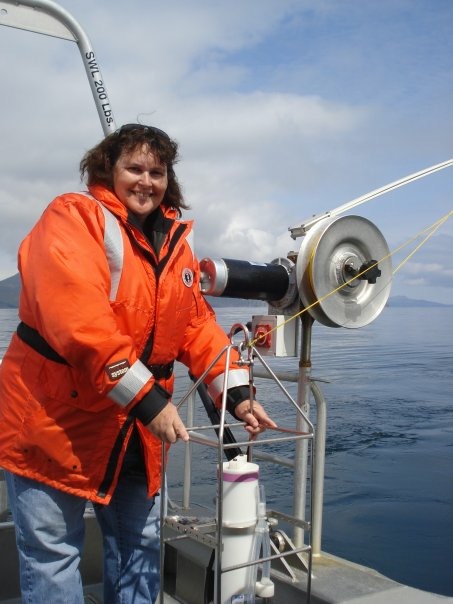 Mary Patterson, a 2014-2015 Albert Einstein Distinguished Educator Fellow, 2014-2015 PBS Digital Innovator, and 2009 NOAA Teacher at Sea, has over 30 years of classroom teaching experience at both the elementary and middle school levels. Currently, she is the Campus Content Instructional Specialist for Science, Grades 6 through 8, at Hopper Middle School in Cypress Fairbanks ISD in Cypress, Texas.
Mary Patterson, a 2014-2015 Albert Einstein Distinguished Educator Fellow, 2014-2015 PBS Digital Innovator, and 2009 NOAA Teacher at Sea, has over 30 years of classroom teaching experience at both the elementary and middle school levels. Currently, she is the Campus Content Instructional Specialist for Science, Grades 6 through 8, at Hopper Middle School in Cypress Fairbanks ISD in Cypress, Texas.
For students to become interested in STEM careers, Patterson strongly feels that early career awareness and positive role models are critical. In 2011, a Fund for Teachers grant enabled Patterson to travel to Taiwan and the Carnegie Mellon Robotics Academy to investigate robotics and emerging technological advances. In 2009, Patterson was a National Oceanic and Atmospheric Administration (NOAA) Teacher at Sea. She spent nearly a month on a research ship doing hydrographic surveys in the Pavlov Islands in the Aleutian Island chain in Alaska. In 2006, another Fund for Teacher grant took Patterson half-way around the world to Australia and New Zealand to explore the natural history, ecosystems, and geology of the areas. “Each of these experiences greatly impacted my teaching. I was able to bring back real-world, hands on activities that modeled numerous STEM careers for my students and my students saw me as a scientist. Students said they never knew there were so many different jobs on a ship and now they could see themselves doing science as a career.”
 Fran Hess (a National Board Certified Teacher, past Science Teachers Association of New York State president, former NSTA District IV Director, and Earth Science textbook author) has many years of classroom teaching experience at both the middle and high school levels. Currently, she provides professional development opportunities and mentors teachers across the United States.
Fran Hess (a National Board Certified Teacher, past Science Teachers Association of New York State president, former NSTA District IV Director, and Earth Science textbook author) has many years of classroom teaching experience at both the middle and high school levels. Currently, she provides professional development opportunities and mentors teachers across the United States.
Hess says, “Middle school students, while they can be the most vibrant and challenging, are also the most rewarding students to teach. Teachers need to support and challenge them to strive in the sciences beyond what they may consider are their limits and capabilities. One way teachers can do this is for teachers to take advantages of opportunities to travel, bringing students with them through a variety of mechanisms including through the use of the latest technology, to places they may never have the opportunity to experience otherwise. Show them the world as you help them understand their importance in the global environment so that each one of them can envision themselves as a vibrant part of planet Earth, able to make a difference in the world in which they live.”
Join Us!
If you are a member of NSTA, I invite you to apply to serve on the Committee for Middle Level Science Teaching. Join us as we seek to share and collaborate on promising ideas elevating teacher voice and teacher leadership at the middle level.
To apply to serve on our middle level committee or another NSTA advisory board or panel, please visit: http://www.nsta.org/about/governance/advisoryboards.aspx. The application deadline is December 1, 2015.
Kenneth L. Huff serves on the NSTA Board of Directors as the Division Director for Middle Level Science Teaching. He is a science and math teacher in Williamsville Central School District, Williamsville, New York.
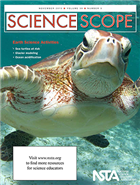 Get more involved with NSTA! Join today and receive Science Scope, the peer-reviewed journal just for middle school teachers; connect on the middle level science teaching list (members can sign up on the list server); or consider joining your peers for Meet Me in the Middle Day (MMITM) at the National Conference on Science Education in Nashville this spring (sign up to present at MMITM here).
Get more involved with NSTA! Join today and receive Science Scope, the peer-reviewed journal just for middle school teachers; connect on the middle level science teaching list (members can sign up on the list server); or consider joining your peers for Meet Me in the Middle Day (MMITM) at the National Conference on Science Education in Nashville this spring (sign up to present at MMITM here).



